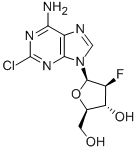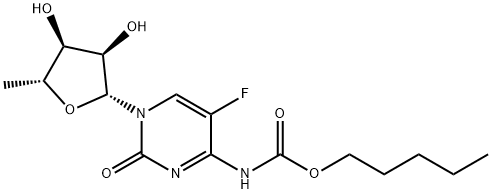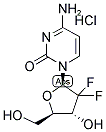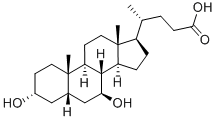Clofarabine , 99% , 123318-82-1
Synonym(s):
(2R,3R,4S,5R)-5-(6-amino-2-chloropurin-9-yl)-4-fluoro-2-(hydroxymethyl)oxolan-3-ol, 2-chloro-2′-arabino-fluoro-2′-deoxyadenosine
CAS NO.:123318-82-1
Empirical Formula: C10H11ClFN5O3
Molecular Weight: 303.68
MDL number: MFCD00871077
EINECS: 631-422-9
| Pack Size | Price | Stock | Quantity |
| 5MG | RMB44.80 | In Stock |
|
| 20MG | RMB87.20 | In Stock |
|
| 25MG | RMB159.20 | In Stock |
|
| 100MG | RMB440.00 | In Stock |
|
| 500MG | RMB1519.20 | In Stock |
|
| others | Enquire |
PRODUCT Properties
| Melting point: | 228-2310C |
| Boiling point: | 550.0±60.0 °C(Predicted) |
| Density | 1.4804 (estimate) |
| RTECS | UD7473000 |
| storage temp. | 2-8°C |
| solubility | DMSO: >10mg/mL |
| form | Powder |
| pka | 12.56±0.70(Predicted) |
| color | white |
| λmax | 263nm(EtOH)(lit.) |
| Merck | 14,2372 |
| InChIKey | INHHKRVRRUIAPA-KJHIFWANSA-N |
| CAS DataBase Reference | 123318-82-1(CAS DataBase Reference) |
Description and Uses
Clofarabine is a new member of the purine nucleoside antimetabolite class of drugs, and it was launched as an intravenous infusion for treating pediatric patients (1–21 years old) with relapsed or refractory acute lymphoblastic leukemia (ALL) after at least two prior regimens. Adenosine-related antimetabolites, such as cladribine and fludarabine have proven successful in treating low-grade lymphomas, chronic lymphocytic leukemia, and hairy-cell leukemia. Although structurally similar to cladribine and fludarabine, a key differentiator for clofarabine is the presence of a fluorine in the C-2′ position, which renders it less susceptible to phosphorolytic cleavage of the glycosydic bond and inactivation by purine nucleoside phosphorylases. In addition, the C-2′ fluoro group improves the acid stability relative to its predecessors. As seen with other purine nucleoside analogs, the mechanism of action of clofarabine involves intracellular phosphorylation to active triphosphate by 2′ -deoxycytidine kinase, and subsequent inhibition of RNA reductase and DNA polymerase a. Clofarabine is cytotoxic to rapidly proliferating and quiescent cancer cell types in vitro.The higher potency of clofarabine relative to other purine nucleoside analogs is attributed to the higher efficiency of its phosphorylation by deoxycytidine kinase, and the longer intracellular half-life of the triphosphate metabolite (>24 h). The chemical synthesis of clofarabine involves the conversion of 2-deoxy-2-β-fluoro-1,3,5-tri-O-benzoyl- 1-α-D-arabinofuranose to the corresponding bromosugar with hydrogen bromide, subsequent coupling with 2-chloroadenine, and the removal of benzoyl protecting groups with catalytic sodium methoxide in methanol. The recommended pediatric dosage of clofarabine is 52mg/m2 daily, administered by i.v. infusion over 2 h, for 5 consecutive days. Treatment cycles are repeated following recovery or return to baseline organ function, approximately every 2–6weeks.Clinical efficacy of clofarabine was evaluated in a single-arm study involving 49 pediatric patients, who had relapsed or failed two or more prior therapies. Fifteen patients (30.6%) demonstrated either a complete remission, a complete remission minus platelet recovery, or a partial response. For patients experiencing complete remission, the response lasted from 43 days to >160 days. Adverse events associated with clofarabine were similar to other chemotherapy agents, including vomiting, nausea, febrile neutropenia, and diarrhea.
Clofarabine has been used in a cell viability assay to analyze the sensitivity of the isogenic cell lines towards clofarabine. It is also used to study the interaction of anticancer drug clofarabine with human serum albumin and human α-1 acid glycoprotein.
Safety
| Symbol(GHS) |   GHS07,GHS08 |
| Signal word | Warning |
| Hazard statements | H302+H312+H332-H315-H319-H335-H351 |
| Precautionary statements | P280-P301+P312-P302+P352+P312-P304+P340+P312-P305+P351+P338-P308+P313 |
| Hazard Codes | T |
| Risk Statements | 25 |
| Safety Statements | 45 |
| RIDADR | UN 2811 6.1 / PGIII |
| WGK Germany | 2 |
| HazardClass | 6.1 |
| HS Code | 29349990 |




